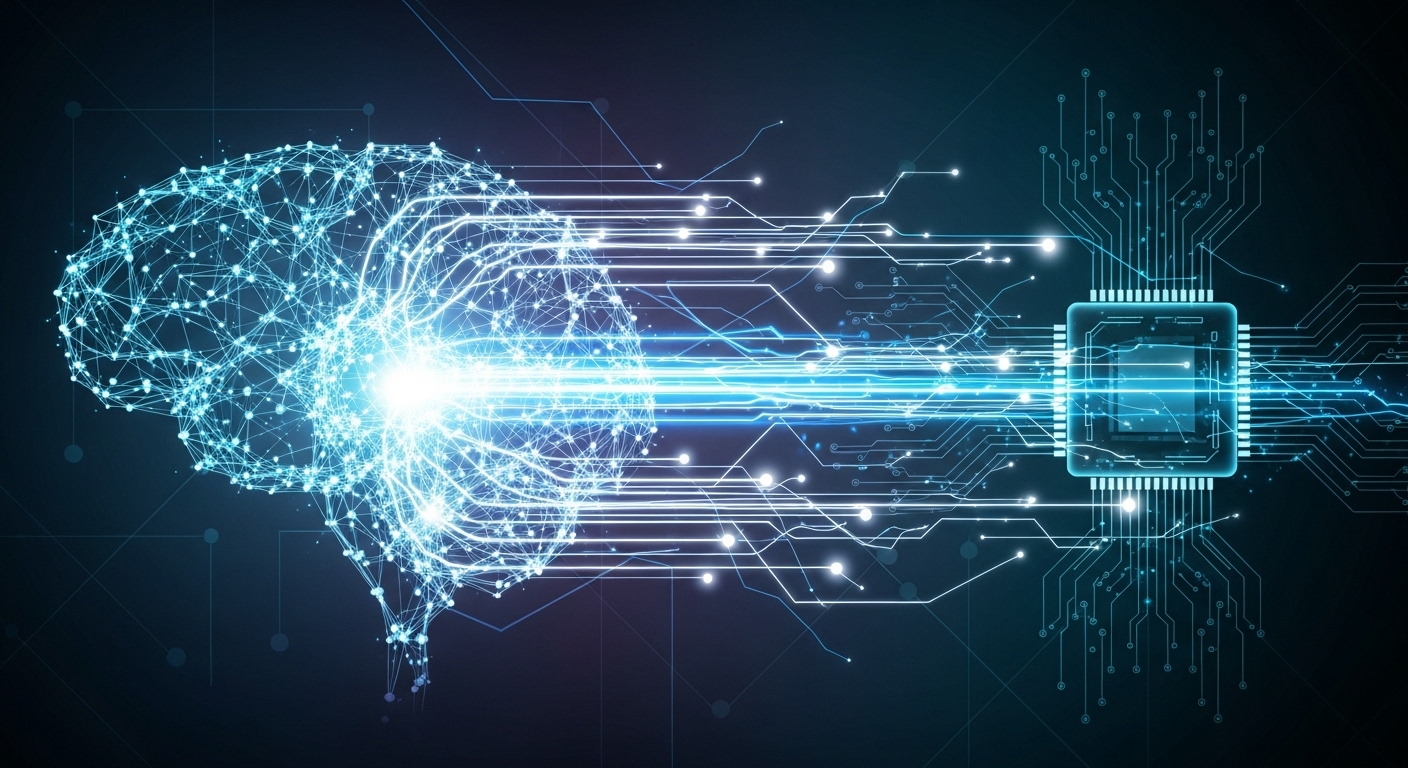NVIDIAの支配を打ち破る!中国AI「Spiking Brain」が実現する驚異の100倍高速化と次世代ブレイクスルーの全貌
人工知能(AI)の進化は目覚ましく、特にディープラーニングモデルはその性能で世界に衝撃を与え続けています。しかし、その発展の裏側には、膨大な計算リソースとそれに伴う莫大なエネルギー消費という課題が横たわっていました。そんな中、中国から発表された「Spiking Brain 1.0」は、NVIDIAのような既存の高性能GPUに依存せず、最大100倍の高速化と劇的な省エネルギー化を実現する可能性を秘めた、次世代AIのブレイクスルーとして世界中の注目を集めています。
「Spiking Brain」とは何か?脳型AIの核心に迫る
「Spiking Brain 1.0」が基づくのは、人間の脳の神経細胞(ニューロン)の働きを模倣した「スパイキングニューラルネットワーク(SNN)」という技術です。従来のAIが連続的なデータ処理を行うのに対し、SNNは脳のように「スパイク」(電気パルス)という離散的なイベントを介して情報を伝達・処理します。これにより、必要な時に必要なニューロンだけが活動するという「イベント駆動型処理」が可能となり、極めて高いエネルギー効率を実現します。
中国科学院(CAS)の科学者チームが開発したSpikingBrain 1.0は、大規模な脳型AIシステムであり、このアプローチがTransformerベースのAIモデルが抱える課題、特に膨大な計算能力とデータセットの必要性に対する中国独自の解決策として注目されています。
NVIDIA不要!なぜ100倍の高速化と省エネが可能なのか
Spiking Brain 1.0の最大の魅力は、その驚異的な速度と効率性です。特定のテストでは、100万トークンのコンテキストから最初のトークンを生成する際に、従来のTransformerアーキテクチャと比較して26.5倍の高速化を達成し、さらに400万トークンという超長文コンテキストの処理では最大100倍の速度向上を実現しています。 この画期的な性能は、SNNが持つ以下の特性によって支えられています。
- イベント駆動型処理: 必要に応じてのみニューロンが発火するため、無駄な計算が大幅に削減されます。これにより、計算のスパース性(疎性)が最大69%に達し、特殊なニューロモルフィックチップと組み合わせることで最大89%ものエネルギー節約が可能となります。
- データ効率: 従来のモデルが要求する事前学習データのわずか2%未満で、言語理解や推論タスクにおいて既存のオープンソースモデルと同等の性能を発揮します。これは、大規模なAIモデルにとってデータソースの枯渇という問題への有望な解決策となり得ます。
- NVIDIAからの脱却: 米国による輸出規制の強化を受け、中国はNVIDIA製GPUへの依存度を減らすため、国産AIチップの開発を加速させています。SpikingBrain 1.0は、MetaXなどの中国国内で開発されたGPU上で完全に学習されており、米国の技術に依存しないAIエコシステムの構築に向けた大きな一歩となります。
中国のAI戦略とグローバルなインパクト
中国は、「中国製造2025」のような国家戦略のもと、半導体およびAI技術の自給自足を目指しており、SpikingBrain 1.0はその取り組みの象徴と言えます。ファーウェイのAscendシリーズのような国産AIチップもNVIDIAの代替品として競争力を高めており、中国企業は独自のAIハードウェアとソフトウェア(例えばCANN)のエコシステム構築に力を入れています。 このような動きは、今後のAI開発競争において、米国が主導するTransformerベースのアプローチとは異なる、「脳型」という新しい道を切り拓く可能性を示唆しています。
SpikingBrain 1.0のような脳型AI技術は、法的文書分析、医療記録、DNA配列モデリングなど、超長文シーケンスを扱うアプリケーションで特に価値を発揮すると期待されています。 また、低消費電力であるため、エッジAI、ロボット工学、IoTデバイスなど、限られたリソースの環境でのAI導入を加速させる可能性を秘めています。
次世代ブレイクスルーへの展望
SpikingBrain 1.0の発表は、AI分野における中国の技術力と革新性を示すものであり、今後のAI研究開発の方向性に大きな影響を与えるでしょう。オープンソース化されたことで、世界中の研究者がこの技術にアクセスし、持続可能なAI開発に向けたグローバルな協力が促進されることも期待されます。
もちろん、従来のGPUの性能やエコシステムに追いつくための課題は依然として存在します。しかし、「Spiking Brain」のような脳型AIが提示するエネルギー効率と処理速度の飛躍的な向上は、AIが直面する資源問題の解決に貢献し、より広く社会にAIが浸透する未来を切り開く鍵となるはずです。NVIDIAの牙城を崩す可能性を秘めた中国の「Spiking Brain」は、AIの未来図を大きく塗り替える次世代のブレイクスルーとして、その動向から目が離せません。
China’s AI ‘Spiking Brain’ Unleashes 100x Speed, Redefining the NVIDIA-Dominated Era: A Next-Gen Breakthrough!
In a stunning leap forward that could fundamentally reshape the global artificial intelligence landscape, Chinese researchers have unveiled an AI model dubbed “SpikingBrain 1.0.” This groundbreaking system reportedly achieves speeds up to 100 times faster than conventional AI while dramatically reducing power consumption, and most critically, operates entirely independent of NVIDIA’s ubiquitous GPUs. This development signals a monumental shift towards a new era of brain-inspired computing, with profound implications for both technological innovation and geopolitical dynamics.
The NVIDIA Hegemony and the Quest for Independence
For years, NVIDIA’s powerful Graphics Processing Units (GPUs) have been the undisputed workhorses of modern AI. Their parallel processing capabilities have fueled the rapid advancements in deep learning, from large language models like ChatGPT to complex image recognition systems. However, this dominance has also created a bottleneck, with high demand driving up costs and creating significant reliance on a single vendor. More acutely, for China, escalating U.S. export controls on advanced AI chips have intensified the urgency to develop homegrown alternatives and achieve technological self-sufficiency.
This geopolitical tension has spurred immense investment and innovation in China, with companies like Huawei expanding their AI chip ambitions and research institutions pushing the boundaries of novel computing architectures. The emergence of SpikingBrain 1.0, running on China’s domestically developed MetaX chip platform, is a direct and potent response to this challenge, carving a distinct path beyond traditional GPU-centric AI.
Unpacking the “Spiking Brain” Paradigm: What are Spiking Neural Networks (SNNs)?
At the heart of this breakthrough lies the concept of Spiking Neural Networks (SNNs), a third generation of neural networks that more closely mimic the human brain’s biological processes. Unlike traditional Artificial Neural Networks (ANNs) that process information continuously, SNNs communicate through discrete electrical impulses, or “spikes,” much like biological neurons. Neurons in an SNN “fire” only when a certain threshold of input is reached, making them inherently event-driven and sparse.
This event-driven nature is the “secret sauce” behind SNNs’ remarkable energy efficiency. While conventional AI models often activate entire networks, leading to significant power consumption, SNNs conserve energy by triggering only the necessary neurons. The human brain, for instance, operates with a mere 20 watts of power, vastly more efficient than current AI systems that can consume hundreds of watts per second. SpikingBrain 1.0 embodies this principle, demonstrating that intelligence can emerge from these selective, energy-saving spiking neurons.
SpikingBrain 1.0: A Quantum Leap in Speed and Efficiency
Developed by the Institute of Automation under the Chinese Academy of Sciences (CASIA), SpikingBrain 1.0 represents the world’s first “brain-like” large language model (LLM) capable of full-process training and inference on a domestically developed GPU computing platform. The performance claims are staggering: researchers report that SpikingBrain can operate “25 to 100 times faster than normal AI models” in various scenarios, with some tests showing “more than 100 times” the speed for processing ultra-long sequences.
One key to its efficiency is its departure from the traditional Transformer architecture’s “attention” mechanism, which processes all words in a sentence simultaneously. Instead, SpikingBrain 1.0 selectively focuses on nearby words, akin to how the human brain processes recent context in conversations. This selective attention dramatically reduces computational demands. Furthermore, the model achieved comparable performance to mainstream open-source models while requiring “less than 2% of the training data” typically consumed by conventional AI systems. This addresses a growing challenge in AI: the diminishing availability of data for training ever-larger models, suggesting that smarter design, not just bigger datasets, is the path forward.
The Full Picture: Implications and Next-Generation Breakthroughs
The implications of China’s SpikingBrain 1.0 are far-reaching:
- Hardware Independence: Running on the MetaX chip platform, this breakthrough signifies China’s accelerated progress toward a self-sufficient AI ecosystem, reducing its reliance on foreign technology.
- Unprecedented Energy Efficiency: The inherent low-power nature of SNNs makes SpikingBrain ideal for edge AI applications—think smart devices, autonomous vehicles, and robotics—where processing happens locally, instantly, and sustainably.
- Real-time AI and Ultra-Long Sequence Processing: The reported 100x speedup, especially for long contexts, opens doors for transformative applications in fields requiring rapid decision-making and extensive data analysis, such as legal document review, medical diagnostics, and scientific simulations.
- A New AI Paradigm: SpikingBrain 1.0 represents a significant step towards truly brain-inspired AI, potentially leading to systems that learn more efficiently, adapt dynamically, and exhibit more human-like intelligence. This marks a fundamental shift in the future of computing.
- Global Competition: This innovation intensifies the global race in neuromorphic computing, positioning China as a key player in defining the next generation of AI hardware and software architectures.
Beyond SpikingBrain 1.0, other Chinese institutions are also making significant strides in neuromorphic computing. Zhejiang University’s Darwin3 chip and the Darwin Monkey system, featuring over 2 billion artificial neurons, are examples of parallel efforts aimed at simulating brain activity and advancing brain-inspired AI research. Additionally, Fudan University has achieved breakthroughs in integrating memory, learning, and perception into a single 2D semiconductor neuron, further pushing the boundaries of ultra-low-power AI chips.
Challenges and the Road Ahead
While the claims are impressive, SNNs still face challenges in widespread adoption, including the complexity of programming and the need for further mature hardware-software co-design. However, the open-sourcing of a 7-billion-parameter version of SpikingBrain 1.0 and a public test page for its 76-billion-parameter counterpart indicates a commitment to fostering broader research and development in this promising field.
This Chinese breakthrough heralds a future where AI is not only powerful but also vastly more efficient and accessible, potentially democratizing advanced intelligence beyond the confines of resource-intensive data centers. The “Spiking Brain” is not just a technological marvel; it’s a strategic move that could redefine the very foundations of AI computing for decades to come.



